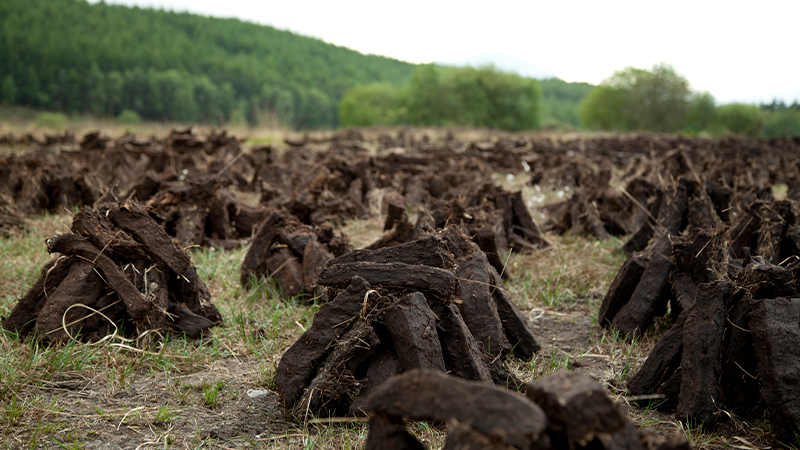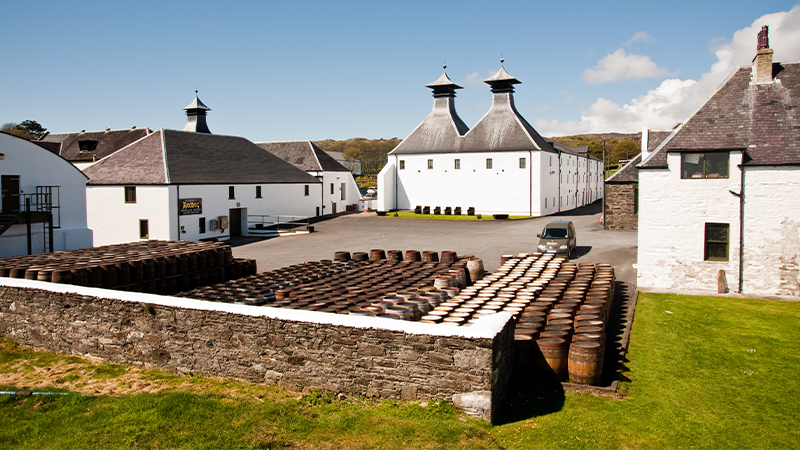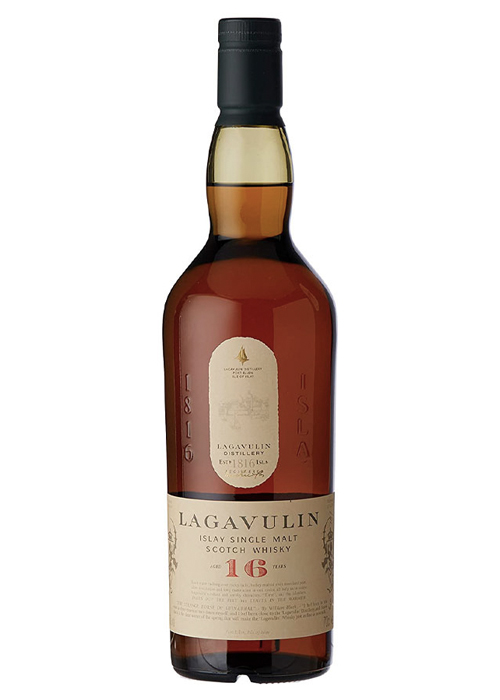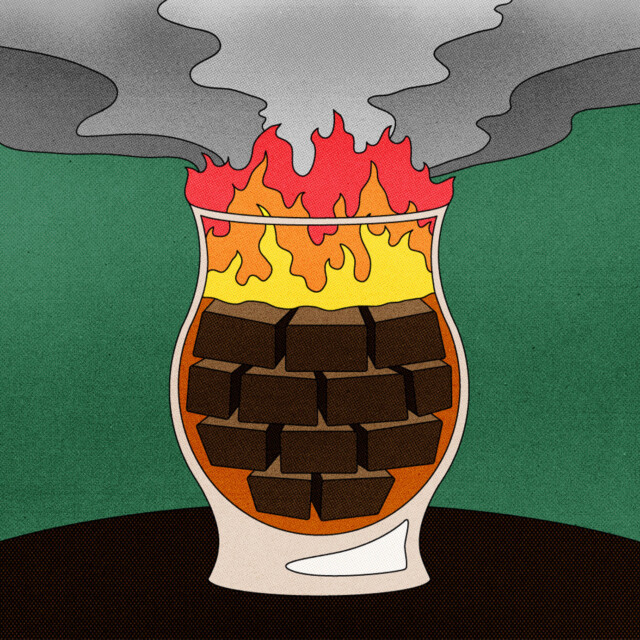Peated whisky hasn’t always been part of the popular crowd. Rich and full of deep, smoky flavors, it has a spectacularly complex profile. An acquired taste? Sure. But for those who enjoy nuanced earthy notes and the charred taste of a burning campfire, peated whisky offers an endless world of exploration.
The intensity and flavor profile of peated whisky varies greatly depending on the region where it’s produced. However, generally they cover a broad spectrum, including intense aromas and flavors of sulfur, saline, diesel, leather, meat, moss, pine, and savory charred wood.
With a range of different styles, smoke levels, and origins — both within Scotland and beyond — the key to enjoying this unique whisky is appreciating what makes it so special.
Here’s everything you need to know about peated whisky.
What Is Peat?

Made from a mixture of decayed vegetation, peat is typically found in moist environments such as swamps and bogs. Peat bogs develop very slowly, often over thousands of years. Loosely formed into brick-like shapes and texturally close to a sponge, what makes peat so important as a resource is its high carbon content. Essentially a supercharged pellet of energy, peatlands contain more carbon than all other types of vegetation combined, which has led to the resource’s historic use as a fossil fuel.
How Peated Whisky Is Made
Some of the world’s oldest and largest supplies of peat are found in Scotland where they can grow up to 8 meters deep. With such a vast stock, peat has long been an accessible fuel source for the nation’s distilleries, which initially used it to fire pot stills.
Today peat is used less for fuel and more for flavor. The peaty, smoky flavor makes its way into whisky during the malting stage of production. At this time, barley is dried using a peat-fired kiln to halt the malting process. Flavors from the peated smoke permeate into the grain, then carry through the entire production process, from mashing, fermentation, and distillation, to maturation and into the final whisky in the bottle.
Where Is Peated Whisky Made?
Though now produced around the world, peated whisky is most commonly associated with Scotland. Like soil and wine, peat can impart a sense of place into the whisky, and flavors can vary depending on where the peat was harvested.
In Scotland, there are five main areas of general whisky production: the Lowlands, Highlands, Speyside, Campbeltown, and Isaly, which is most notable for its peated drams. Each region is unique in its own way and offers a vast range of profiles and styles of whisky.
Lowland: Located just north of Scotland’s border with England, this region is known for producing softer-style whiskies. Its mellow flavor often has light notes of toffee, toast, and sweet honeysuckle. The lighter characteristics of the whiskies made here often provide a nice balance to the smoky flavors of peat, and are therefore a great base for blended Scotches
Highland: The Highlands offer a range of diverse flavors and the region is known to produce both light- and fuller-bodied whiskies. Though peated whiskies remain the minority in this area, it is undoubtedly the largest whisky region in Scotland. Some variations to sample from this region are Oban 14 and several styles from Highland Park.
Speyside: Speyside is home to over half of the active distilleries in Scotland. Whiskies from this area tend to have fruit-forward flavors with scents of smoke trailing throughout. Some are matured in sherry casks, which can impart distinct notes of dried fruits and nuts. For novice drinkers, BenRiach The Smoky Twelve offers a subtle waft of smoke that makes for a great intro to the style.
Campbeltown: Peated whiskies made in this region tend to have more of a delicate smoke profile, with subtle mineral notes and robust character.
Islay: Located on the southwest coast of Scotland, Islay is the largest of the Hebridean Islands and is often referred to as the Queen island. Its tricky-looking name is pronounced “eye-la” as opposed to “is-lay.” Despite being more remote than other islands, it houses nine working distilleries and is among the most recognizable locations for peated whisky in the world.

Legacy brands such as Laphroaig, Lagavulin, Ardbeg, and Bowmore all call Islay home. Giants in their own right, Laphroaig, Lagavulin, and Ardbeg are collectively known as the Kildalton Distilleries for their adjacent locations. This, along with the reopening of several prominent distilleries, including Bruichladdich, one of Islay’s oldest facilities, has made the island a popular destination for tourists.
The famed Islay distilleries produce some of the most heavily peated whiskies in the world, including Laphroaig and Octomore by Bruichladdich.
Outside of Scotland
There are many other countries crafting peated whiskey including Japan, India, the U.S, Taiwan, Sweden, and Australia.
Japan: With a few exceptions, such as the heavily smoked Yamazaki and Hakushu whiskies, Japanese styles tend to be slightly less smoky than those hailing from Scotland. However, the overall use of peat in Japan is quite common as the Ishikari River basin is rich in the material.
India: India is also home to multiple peated whisky brands including Paul John and Amrut, despite having no local peat sources. Instead, bricks or peated malt are imported from Europe, Asia, and the U.S.
America: With an official single malt category on the horizon, it should come as no surprise that several producers across the U.S. have ventured into peated whiskey, including the Westland Distillery in Seattle, Balcones in Texas, and McCarthy’s in Oregon.
How Is Peat in Whisky Measured
The level of peat in a whisky is measured in phenol parts per million (ppm). The ppm levels are pretty high in dried, peated malt before it is processed into alcohol. However, during distillation and maturation, the levels decrease, leaving the finished whisky between 30 and 40 percent of the original peat level.
Most whiskies will fall within the following styles: lighty peated, meaning 15 ppm and below; mildly peated, an average of 20 ppm; and heavily peated, meaning 30 ppm and above. Knowing the ppm of your selection can aid in determining how smoky it may taste.
How Does Aging Affect Peated Whisky?
The aging process is an important step in the production of all whisky. In the case of peated expressions, extended aging periods allow more time for phenols to bond with other elements within the solution. Ultimately, this alters spirit’s aromas and flavors, and leads the intensity of smoke notes to fade over time.
How to Drink Peated Whisky

With such a broad spectrum of profiles and intensities, peated whiskies are often sipped neat or served with a few drops of water to bring the aromas and flavors to life. Discovering the nuances with a whiff or slow sip comes with practice, as the smoke can be a bit overpowering for those new to the style.
There are a number of cocktails, too, that lend themselves well to smoky whisky. The Penicillin is probably the most notable among them, offering a balanced blend of lemon, ginger and honey syrup, and blended Scotch. A finishing float of peated whisky brings the cocktail to life.
A lesser-known combination for peated Scotch is the Smoky Cokey, as mentioned by bartender Adam Montgomerie in an episode of VinePair’s “Cocktail College Podcast.” A highball made with Lagavulin and Coca-Cola, this drink is an easy way to dip your toe into the world peated whisky.
